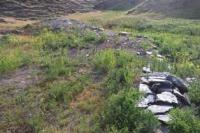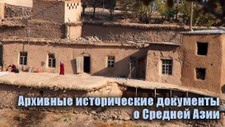You are here
Tanirkazgan site.

Paleolithic sites in Kazakhstan.
"This place where we stopped is called Dashti-Kipchak. In this steppe there are no mountains, hills, basins, forests, firewood, only a plain completely green and very beautiful. The local inhabitants use dung instead of firewood, which they call tazak. You can see how the most important people among them collect dung in the hem of their clothes. Travelers in Dashti-Kipchak travel in carts. Dashti-Kipchak has a space of six months' travel, of which about a three-month's travel is under the authority of Khan Muhammad-Uzbek, the rest is managed by others."
Ibn Battuta. "A gift to those contemplating the wonders of cities and the miracles of travel." 1325 – 1355.
Archaeological research in Zhambyl region.
Lower Paleolithic site of Tanirkazgan is located at an altitude of 505 meters above sea level, 3.3 kilometers southwest of Borikazgan valley, between Tortkuduk and Kyzyl mountains, 12.8 kilometers north and slightly east of city of Karatau, 13.9 kilometers east and slightly north of village of Koktal, 13.6 kilometers south and slightly east of village of Kyzylaut, in Talas district of Zhambyl region.
Tanirkazgan site is one of the oldest archaeological sites in Southern Kazakhstan, dating back to the Lower Paleolithic era. This unique site allows you to look into the distant past of the region and learn about the first people who inhabited the territory of Central Asia.
During the excavations, numerous stone tools were discovered, indicating that ancient people had been in this place for a long time. The Tanirkazgan site dates back to the Lower Paleolithic, making it one of the oldest in Central Asia. Scientists suggest that the age of the finds may reach hundreds of thousands of years.
The discovered artifacts are similar to the tools of the Acheulean culture, which was widespread in Eurasia during this period. This indicates that the early people who inhabited Tanirkazgan used technologies typical of ancient communities of hunters and gatherers.
The Tanirkazgan site plays an important role in the study of early human migrations in Central Asia. It confirms that ancient people had mastered this region long before the emergence of the first civilizations. Research on the site helps scientists better understand how the first people settled, what skills they had, and what technologies they used.
History of Tanirkazgan site study.
The remains of Paleolithic stone products were first discovered by archaeologist H.A. Alpysbayev in 1968 on a flat hill made of sandstone. More than 30 years later, in 2000, the South Kazakhstan Complex Archaeological Expedition of the A.Kh. Margulan Institute of Archaeology, led by K.M. Baipakov, re-examined this territory.
The size of the site does not exceed 1 square kilometer. During the excavations, pits were dug, and in the upper layer of gray loam, researchers discovered a significant number of artifacts. As in the Borikazgan site, the ancient people of Tanirkazgan used black and dark gray flint to make tools.
Flint and quartzite tools - choppers, scrapers, flakes, used for processing food, wood and animal skins. Traces of fire pits are evidence that ancient people already knew how to control fire. Bone remains of animals - it is assumed that ancient hunters ate the meat of large mammals.
These finds indicate that Tanirkazgan was a place of long-term or repeated stay of ancient people. The discovery of this monument was an important event in the study of the prehistoric past of the region. Stone finds are conventionally divided into several types:
Rough, double-sided Lower Paleolithic site of Tanirkazgan processed chopping tools;
Disk-shaped products;
Tools resembling hand axes;
Unifaces (tools with only one side processed);
Tools made from flakes;
Nuclei (cores from which blanks for tools were chipped)
Flakes without traces of secondary processing. In their characteristics, stone products from Tanirkazgan find analogies among the most ancient artifacts of Eurasia and Africa, including tools of the Olduvai culture. The entire collection of archaeological finds is now stored in the Museum of Archaeology of the A.Kh. Margulan Institute of Archaeology in Almaty.
The Tanirkazgan site is a valuable archaeological site that reveals new pages in the history of the settlement of Central Asia. It allows us to see what the world of ancient man was like, his way of life, ways of survival and adaptation to the environment. Research into this monument continues, and perhaps in the future it will give science even more amazing discoveries.
Geographical coordinates of Tanirkazgan site: N43°17'47 E70°28'25
Photos by:
Alexander Petrov.







